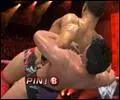Several improvements has been added to the gameplay experience in SmackDown vs. Raw 2011. Not only the new dinamic physics, but also a large variety of reversals, a revamped Grapple System, out-of-nowhere finishers, pinning combinations and more.
THQ is trying to get away from that canned animation feel of the past. You know, "pull off a move and then just sit back and watch as it plays out." This year, there are more reversals than ever, there's a new move position in being able to sit an opponent on the top turnbuckle, and there are new nuances to master. Remember how dumb you looked in the past performing suplexes that ended in pins during first blood matches? Now, moves like a fisherman's suplex come with an option to pin. You start doing the move and a button prompt will pop up on the screen in case you want to hook the leg and hold for a three-count. In the same vein, the Tree of Woe isn't canned anymore. You hang your opponent by his or her legs from the top turnbuckle and can then do a variety of different grapples and strikes to the prone rival.
In SVR10, a lot of the reversal animations didn’t mesh well with the type of attack being performed. For example, the defender would counter a running calf kick into a drop toe hold which looked absolutely ridiculous because the airborne attacker would suddenly and very awkwardly make the transition into the drop toe hold animation. You’ll be seeing a lot less (hopefully none) of these issues in SVR11. You’ll be seeing a lot less of the non-attack type reversal animations and more actual counter grapple/strike attacks. I’ll give you guys another example of what I’m talking about: let’s say Chris Jericho is attempting to hit Randy Orton with a clothesline. If Orton is successful in his reversal attempt, rather than duck or move out of the way, Orton will be able to counter Jericho’s clothesline into a snap Powerslam (as he is likely to do in an actual match).
The controls themselves haven’t changed drastically. You’ll still be using the right analogue stick to grapple and actions such as striking, Irish whipping, reversing and performing Signature/Finisher moves are performed the same as last year’s title. The only actions that have been changed significantly are dragging and pinning. Pins are now mapped to the B/Circle button and you’ll now be using the left trigger to drag standing and grounded opponents. The biggest change that has been made to the grapple system itself is the removal of the grapple modifier and the inclusion of a new upright grapple attack position. The type of grapple that you’re able to perform on a standing opponent will be dependent upon the condition of your opponent. If you grapple a non-groggy opponent you’ll grab hold of them in one of four different chain grapple holds (front facelock, side headlock, waist lock and wrist lock). Similar to previous titles you’ll be able to perform grapple moves (by moving the right analogue stick up, down, left or right) strikes and struggle submissions from each one of the four holds. If you pull and hold the left trigger while in a chain grapple hold your Superstar will transition into a drag state. While keeping the left trigger held you’ll be able to drag your opponent by moving the left analogue stick. If you release the left trigger you’ll transition back into a chain grapple hold. This time around grapples performed out of chain holds will be your weaker set of grapple attacks. In order to perform strong grapples you’ll need to get your opponent into an upright groggy state. This upright groggy state is a brand new attack position and transitioning opponents into this state can be accomplished multiple ways, for example with Strike combinations, consisting of four strike attacks, that have been re-implemented in SmackDown Vs. RAW 2011 (rapidly pressing the strike button will unleash your strike combination).
Whereas in previous iterations you were only able to perform Signatures and Finishers from one situation, in this year’s wonderful title you’ll be able to execute the same move from more than one situation. The functionality has not been applied to every mode but only to those moves that make sense. The Codebreaker and RKO are frequently performed from a standing position as well as from a run which is why I used those two moves in my initial explanation. So if you’re playing with a Superstar that has the Codebreaker as their Finisher you’ll be able to perform it in two different situations (standing in front and running toward your opponent) but the move will still count as one finisher. You’ll still be able to have another Finisher in addition to the Codebreaker. This functionality has also been applied to Sheamus’ Brogue Kick (Bicycle Kick) Finisher. You’ll be able to perform the Brogue Kick running toward your opponent as well as from an Irish whip rebound.

